Demos Chiang’s solo exhibition “Magizoology” (a word in Harry Potter that represents the study of magic and mythical animals) will be unveiled at the Whitestone Ginza Gallery on January 13th, 2023 and it is the first solo exhibition in Japan for the artist. The opening day for the artist is commemorative as it was the date that his grandfather Chiang Ching-kuo (born Apr. 27, 1910, Fenghua, Zhejiang province, China—died Jan. 13, 1988, Taipei, Taiwan) passed way. Through out his life, no matter what Demos Chiang had took on different identities, either his early study of finance abroad, or his later work in design, even his recent role as an artist, maybe he will always carry the identity as a member of the Chiang’s family.
Demos Chiang did not shy away from this topic when he was interviewed by CAFA ART INFO. He is proud of his identity, but his upbringing has also taught him the complexities of identity. For him, identity is a double-edged sword, always bringing both opportunity and criticism. The struggles during his youth, have gradually been refined into a more free and cultivated attitude to life after he turned 40, which permeates and spreads loosely in the paintings he creates.

Major Visual Painting: Demos Chiang, Cross, 2022. Mixed media, canvas, a poem inscribed in English, 140x90cm.
Demos Chiang had an early art enlightenment as a child, he played at Zhang Daqian, Lin Shunxiong (Sun Lin) and other masters’ homes. He liked to paint from then on, so he entered the art club when he was in high school. However when he was confronted with a choice for his college major, he was “dismissed” by his father who liked to collect art but commented that “an artist cannot make a fortune.” After he returned to Taiwan and experienced the twists and turns of life, Demos Chiang still felt that he was attracted by art. In quite a pragmatic way, he chose to establish a business at the intersection between art and commerce, thus he founded a design company and became a designer. The experience that he gained as a designer has laid the foundation for his later art creations.
At the age of 40, Demos Chiang experienced a major change in life, which triggered him to start thinking about what “honest life” is. It was also then that he officially decided to shift from design to art. After he was represented by the gallery, he went through different stages: from exploring the market, pursuing artistic evaluation to academic exploration, and returning to explore the market again in recent years, Demos Chiang’s path to become an artist started almost at the second half of his life, and every step was not easy at all. In his heart, choosing to be an artist means that he can be infinitely closer to the impression left by the art masters he had encountered in youth: ego, freedom, and even “madness.” With age, these values had became the most precious self-preservations for the artist to chase after, Demos Chiang gradually understood that they had an unbreakable ego and the art world defended themselves.
Art, for Demos Chiang, also points to an ideal little world. He described himself jokingly, during his rebellion period that he experienced since being 10 years old has not yet passed. In his opinion, “the crazy passion that an artist possesses is defined as rebellious to the norm. But all the artist wants is to have a little world that he can claim to be his and in that world, he can achieve complete freedom.” Painting, making sculpturing and installation, are all forms for the artist to express his rebellious in his search for a honest life. The artist realized that he has to first heal himself. And art, is the most important medium in this process) has room for the same deposit in art, which may also be the inner source of Demos Chiang’s choice of art. Just like he was eager to start an honest life after he was 40, and in his opinion, art is a great path to that honest life.
 Demos Chiang, Exploring to Be King, 2022. Mixed media, canvas, a poem inscribed in English, 200x200cm.
Demos Chiang, Exploring to Be King, 2022. Mixed media, canvas, a poem inscribed in English, 200x200cm.
At the beginning of 2020, Demos Chiang found a relatively stable path in painting, sculpture, and installation through the “Release” and the recent “Landscape Animals” series. He refines animal portraits, expressive landscapes and English poems as the three important labels of his work, and further he integrates the direct expression in the West with the spirit of Eastern literati painting.
In his paintings, Demos Chiang prefers and is obsessed with the themes on animals. Mencius said: “The reason that people are different from those beasts is few; ordinary people abandoned it but gentlemen cherished it.” In the history of art, there are a large number of painters who are recognized for painting animals. People can immediately relate to Qi Baishi’s shrimp, Xu Beihong’s horse, Pan Tianshou and Li Kuchan’s eagles ... Animals often appear in an anthropomorphic state in artists’ expressions and they appear as the carrier of their mental temperaments. In Demos Chiang’s paintings, the images of animals are also anthropomorphic, conveying the artist’s pursuit of freedom, unruly spiritual strength and temperament. Through the subtle and enthusiastic expression of ego, he expresses his emotions for his family, lover, friends, and people around him, as well as his sensitivity to the world.
Just as the curator Wang Yuling commented, Demos Chiang used animals to “show his concern for the world, and at the same time, it is also the record and expression of the artist’s emotion.” He uses drip painting technique which is the painting method of Jackson Pollock’s to form figurative animals, and then enhance it. He often describes the realism of animals with brushes and acrylic paint, and combines drip painting Abstract Expressionism in the background. Drawing the expressionistic voyage of landscapes with lacquer, supplemented by his inscribed poems in English, he attempts to create his own uniqueness through combining of poetry, calligraphy and painting of the Eastern art with the Western art style.
Painting animals has internally echoed with sincerity, which is the ultimate art pursuit of Demos Chiang. At the beginning he only paint animals which he had seen. “I prefer painting what I have seen and experienced, if I haven’t seen their eyes, I cannot feel them, let along correctly and realistically express their emotions.” The reason that he likes painting animals is because they are simple and direct, without suspicion, and they always remind critics of Henri Rousseau, another French impressionism artist who was good at painting animals. If Rousseau’s paintings can be describe as “let all the beasts look at the viewers with gentle and sincere eyes, Rousseau thinks that when the soul is free and sincere, there are no boundaries between people and beasts, thus the realm of beauty can be reached.” Then, Demos Chiang is pursuing the realm of freedom and honesty feelings with the same sincerity.

Demos Chiang, Midnight Stoke, 2022. Mixed media, canvas, a poem inscribed in English, 140x90cm.
With the gradual deepening of artistic practices, Demos Chiang started a stronger and more active comprehension of animal themes. He began to find animals that were not portrayed in the traditional Chinese paintings, and started to compare a more modern take by comparing animals that are similar, such as replacing have not been included in the paintings themed on animals in the art from the East and West. There are cow, sika deer, horses in Chinese paintings. With then he goes onto paint rhinos, giraffes, and even animals such as unicorn and dragon that only appear in the Eastern and Western mythologies. They can be regarded as a further exploration in paintings themed on animals, which also reflect a form of rebellion against Chinese paintings, these new works will be also exhibited in the latest exhibition “Magizoology” at the Whitestone Gallery.
In his creation of sculptures, Demos Chiang also tried to continue, merge, and link the spiritual temperament of the Eastern art onto, and with Western sculptural art expression. He excavated and used the expression of “vacuum” in sculpture to express a spatial state that does not exist physically, and at the same time to describe some “synchronization” of individual experience and international situation, just with the global COVID-19 lockdown took place, everything was suspended. In this state, people lived, art has injected the vacuum state without air and is frozen in time. Until the day COVID-19 passes, everything will be unsealed and be back to normal and it becomes an intermediary that one can get liberation and freedom. This unlimited contraction and then an unlimited expansion had become the key language in the artist’ sculpture.
 Demos Chiang, Dragon Leaps, 2023. Stainless steel, L 39.3 x W 39 x H 60cm.
Demos Chiang, Dragon Leaps, 2023. Stainless steel, L 39.3 x W 39 x H 60cm.
Demos Chiang, who entered the art world at the age of 40, brought his “Magizoology”” exhibition to the Whitestone Gallery for the second time, one of the most prestigious galleries in Japan. It was only a year apart from his first exhibition of “Haah Universe” held in the Whitestone Taipei Gallery, which proved his diligence. Perhaps one can relate this character to Chiang’s love for weight training. He often describes himself as a “warrior general”, for he favors challenges instead of dwelling in the comfort zone. His method for progression is more like actively seeking and facing challenges, Chiang describe this action as piling soil, just like the process that he describes fitness, rather than believing in talent, he chose to believe in daily hard work. Regardless of whether he is doing anything or art, he hopes to get inspired from that spirit and that is also the motivation for Demos Chiang to make progress. It is also his own requirement for himself when he works on design, art and any other things.
“Everyone can be born twice. The first time we have no choice, and the second time is when we choose to exist.” This is an English poem inscribed by Demos Chiang on one of his recent paintings that belongs to the series of “Landscape Animals” in 2022. Art has brought him an opportunity to be free, and this unique sense of existence allowed him to immersed into his own little world. Perhaps, this is why Chiang is drawn to art and continue to walk down this path. During the interview by CAFA ART INFO, this may be what Demos Chiang wants to convey to everyone what he feels sincerely about art.

Interviewee: Demos Chiang
Interviewer: Mengxi
Q: Everyone was familiar with your identity as a designer in the past. In recent years, you have engaged in painting creation from the design field. When did this career change start? The origin of your creation is said to be related to the pandemic experience?
Demos Chiang: Actually, I decided to become an artist after the age of 40. Right before the pandemic happened. I enjoyed painting from an early age. This passion carried through high school, but was suspended in college. For my father did not believe an artist could make a living, so I went into business instead.
But I never gave up in art. Hence I started a design firm and became a designer for more than a decade.
At age 40, I was divorced. This is a life changer. I started to think seriously who am I and what I really want. Although these are the questions that had always been in the back of my mind, I never thought I will have the opportunities to actually answer them and execute the answers. My answer was simple, I want to live an honest life. Honesty to myself and others were the pushes that dropped me back into art. For honesty in itself, has to be selfish.
Selfishness is a value I was not familiar with. It is very different than design: a service that is devoted to others. At first, I was very uncomfortable. To admit and surface my true self to the public is very scary. Doubts started to arise: what do you want to say? Why are you an artist? Why did you draw this way? What is the definition of this painting?
I realized that art is not just the process of painting, but an ongoing process of self- exploration and self-assurance.
Later, I signed an agency contract with a gallery. For me, that gallery was too business focused. Instead of coaching the artist, they are more interested in market sells. This affected me. And doing art became a burden. I felt my creation, my animals, were caged. All the way up to the pandemic, I could not shake off this feeling.
But during the pandemic, I encountered my current curator Wang Yuling at my solo exhibition in Taipei. She coached me. Instead of directing me, she guided me. And made me believed in myself again. This time, I found myself and my art.
Currently I am at peace with myself. I Am no longer looking for any specific things. I just enjoy my days and see how the path will unfold. Art, healed me.

Demos Chiang, Star Seeker, 2022. Mixed media, canvas, a poem inscribed in English, 140x90cm.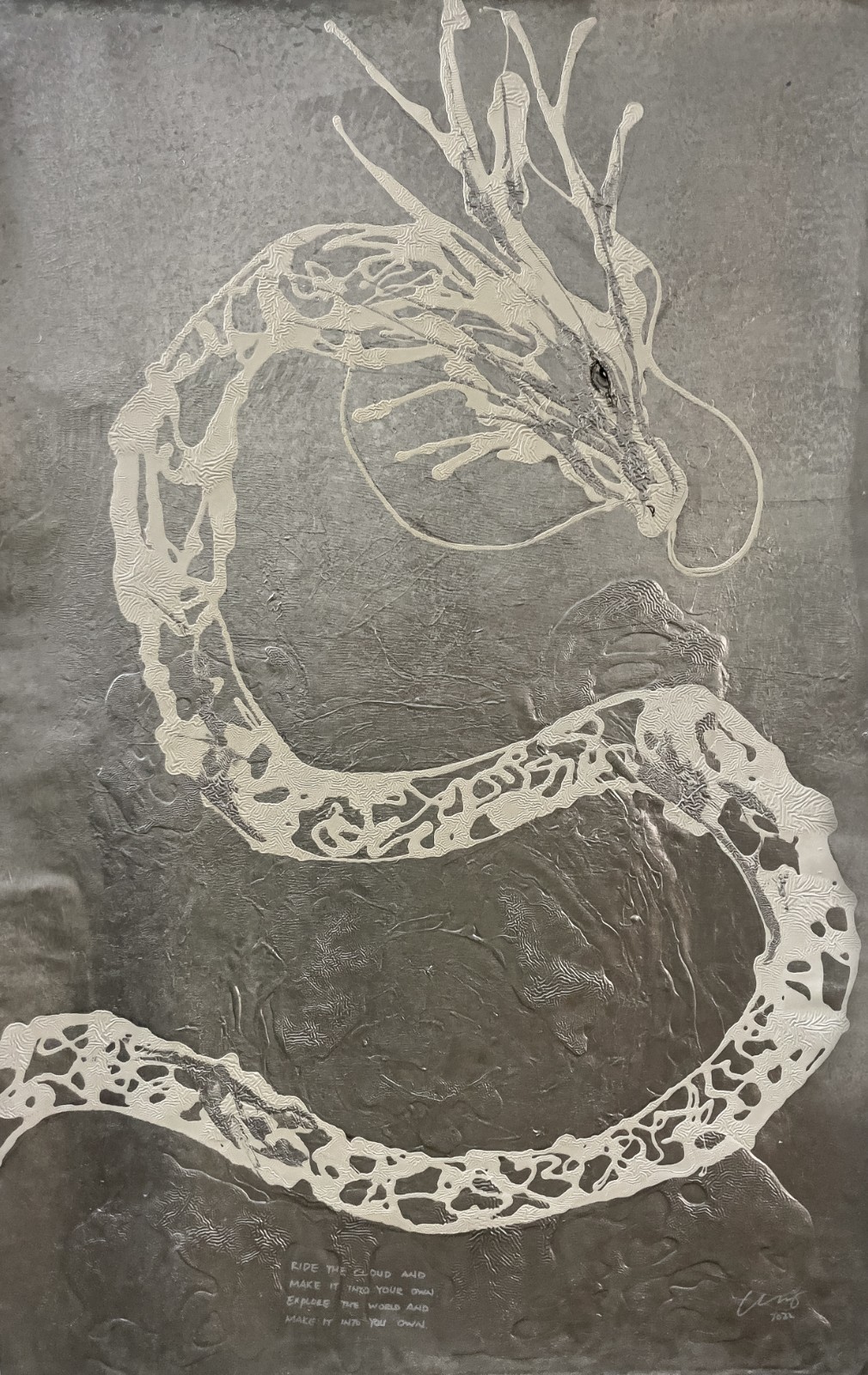
Demos Chiang, Form, 2022. Mixed media, canvas, a poem inscribed in English, 140x90cm.
Q: What kind of artistic influence have you received since you had the opportunity to contact a large number of art works, especially Eastern art?
Demos Chiang: When I was young, I was fortunate to have the opportunity to visit the houses of art masters such as Zhang Daqian, Lin Shunxiong, etc., and interacted with them closely. I remembered that when I went to Zhang Daqian’s home for dinner, he painted right in front of us. And after he finished his painting, he asked me what do I want him to draw? I said that I wanted “Mazinger Z”. Yet, he painted his self-portrait instead. Maybe that’s how he viewed himself. As the all mighty. These memories had became the building blocks for my current creation. It is the attitude that shaped my art.
Another childhood memory was from painting with Lin Shunxiong, a Taiwanese watercolor painter who also focus on painting animals. When I was at his house, he set only one rule for drawing. I must first draw 1000 pairs of eyes before I can paint anything else. He said, “if you cannot paint eyes well, it does not matter how well you draw. If you can draw well and can’t paint eyes, how well you draw will be more important than what you want to draw.” A ridiculous request at youth, became the pillar of my art. I now am very comfortable using eyes to express emotions for my animals.
The common denominator from my encounters with master artists is that they all seems to be a little crazy. It is this confident in what they do attracted me. This became my pursuit now.
In addition to meeting artists in person. I also had the opportunity to play with antique. To be able to hold the antiques in hand, to experience them outside the context of museums provided me a closer interaction with these master pieces. The texture and symbol from bronze, the poems on the back of the fan, the light and shadows in jade…all of these are now a part of my artistic expression. It is true when they say, art is the most honest representation of self.
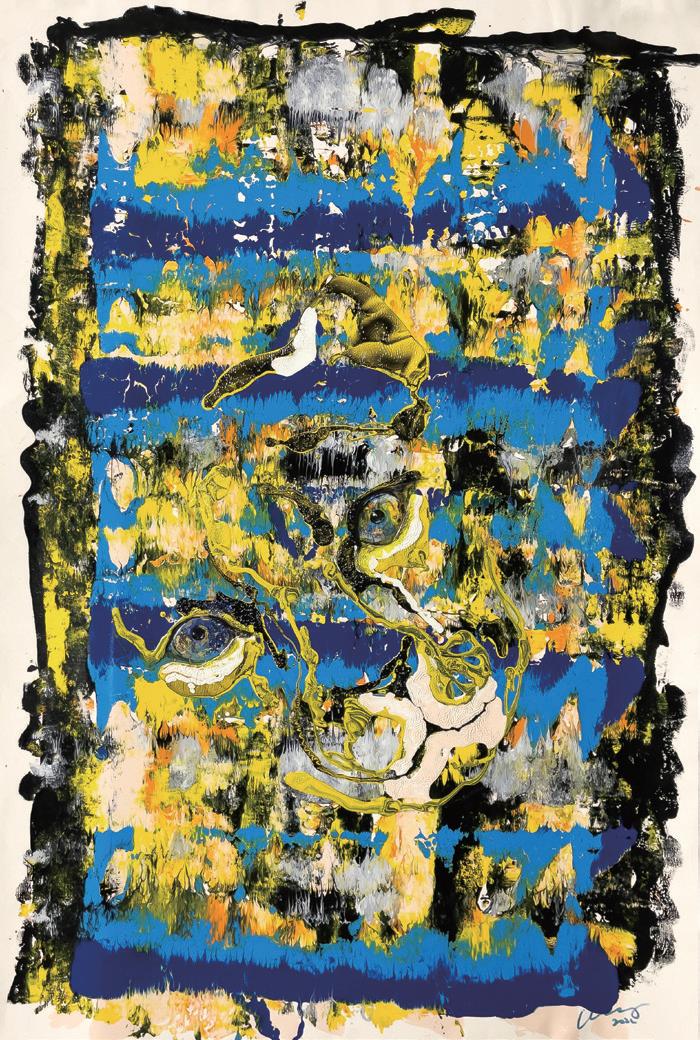
Demos Chiang, Your Planet, My World, 2022. Mixed media, canvas, a poem inscribed in English, 140x90cm.
Demos Chiang, Innocent in Chaos, 2022. Mixed media, canvas, a poem inscribed in English, 89x56cm.
Q: You do not only like to paint eyes, but also like to draw animals. You have drawn a lot of animals such as dragons, lion dance, unicorns, zebra, rabbits, etc. What are you inclined to paint? Where do these images come from?
Demos Chiang: The main reason for choosing animal as a focal point is that I generally prefer animal over human. They are a lot simpler, and much more honest. At the beginning, I could only paint animals that I had seen and sometimes felt. But after a while, I realized that animals are my interpretation for human beings. At this point, I started to bring in animals I had never seen. For it is now all about the feelings.
With this in mind, I start to look for animals that were not common in the traditional Chinese painting. Such as replacing ox with rhino, deer with giraffe, and crane with flamingo. It is a reflection of my rebellious nature.
As for the mythological animals such as unicorns, dragons, etc., I attempt to create a new series for the “Magizoology” exhibition at the Whitestone Gallery. Showing unicorns from the west and dragons from the east in the same exhibition symbolized my perspective of the world and my place in the world. The world had changed, nothing can be clear cut. The east and west are no equally important and should be equal respected.
On the first floor, unicorn and its friends protracted the western definition of heaven. A more personal and innocent ambience. On the second floor, dragons and his friends portrait a more social and grand theme. The similarities and differences between the so-called western heaven and eastern wonderland are presented in parallel.
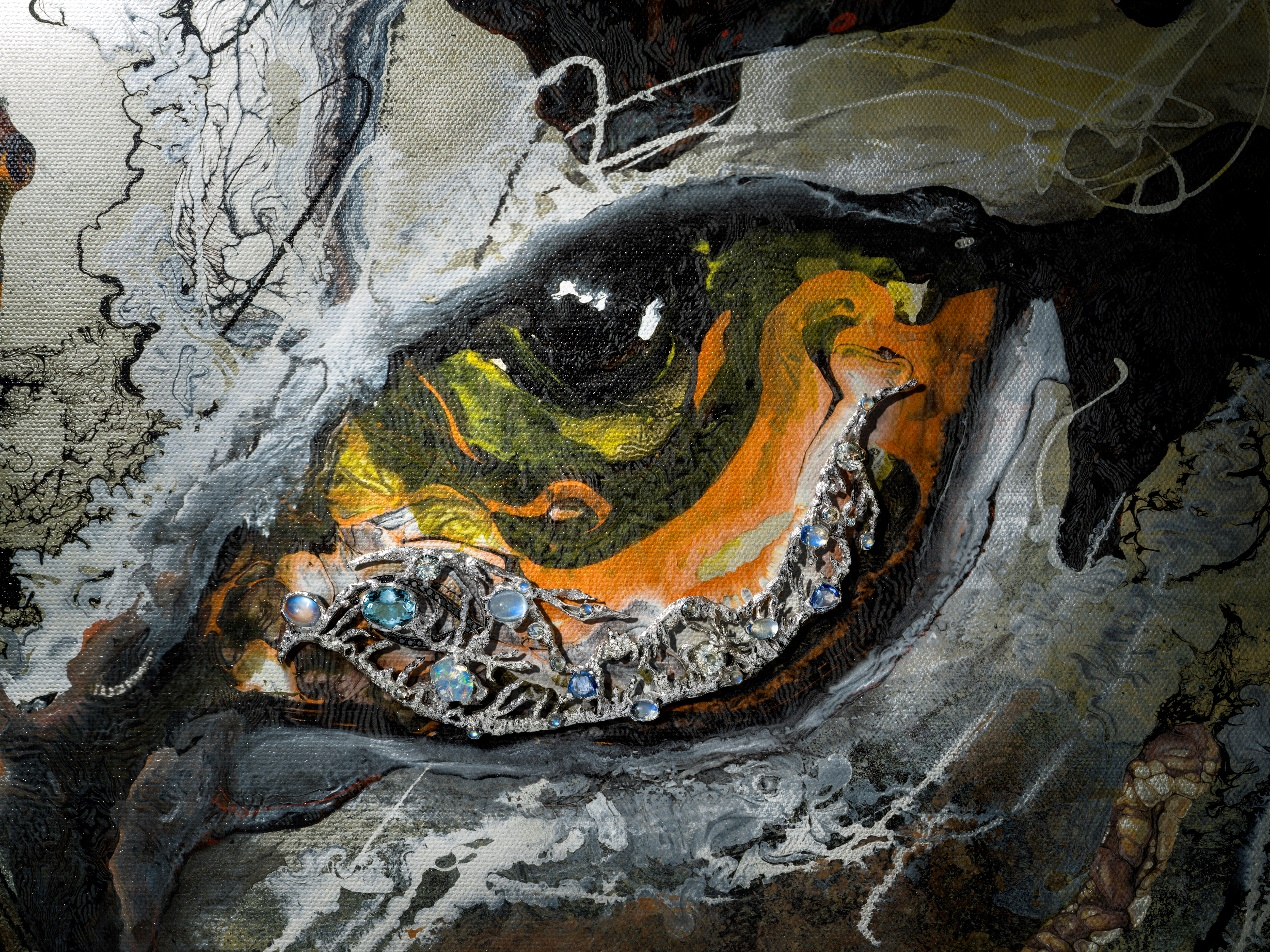
Demos Chiang, Two Sides of a World, 2022. Mixed media, canvas, a poem inscribed in English, 90x140cm(detail) x SHEE (one of the series)
Demos Chiang, Snow Unicorn, 2022. Mixed media, canvas, a poem inscribed in English, 140x90cm.
Q: You have double identities. One is mixed race, and the other is the identity brought by your family. Will your identity cause some confusion in your life? In the face of society and creation, will your identity cause you to choose some symbolic animals on a subconscious level?
Demos Chiang: Identity is for life. I am proud of my background, and it constantly reminded me that I have to walk a path that will make my family proud. Living with honesty and purity is my way of respecting my origin.
Is background a double edged sword? The answer is yes. But only when you are not sure about who you are. If you self-doubt, then you live according to other’s wish. That in term will disable you from reaching your potential. But if you are sure about who you are, then you are living for yourself. And that, will make everything, the ups and downs, into nourishment for life.
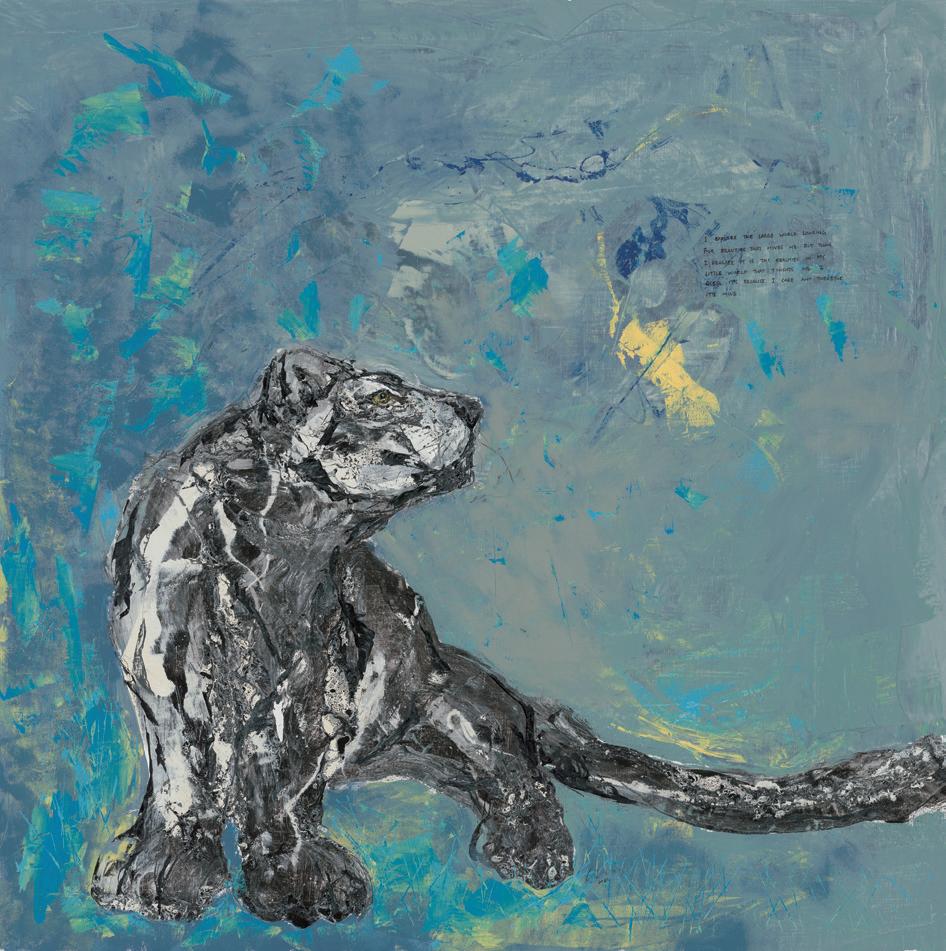
Demos Chiang, Princess, 2022. Mixed media, canvas, a poem inscribed in English, 200x200cm.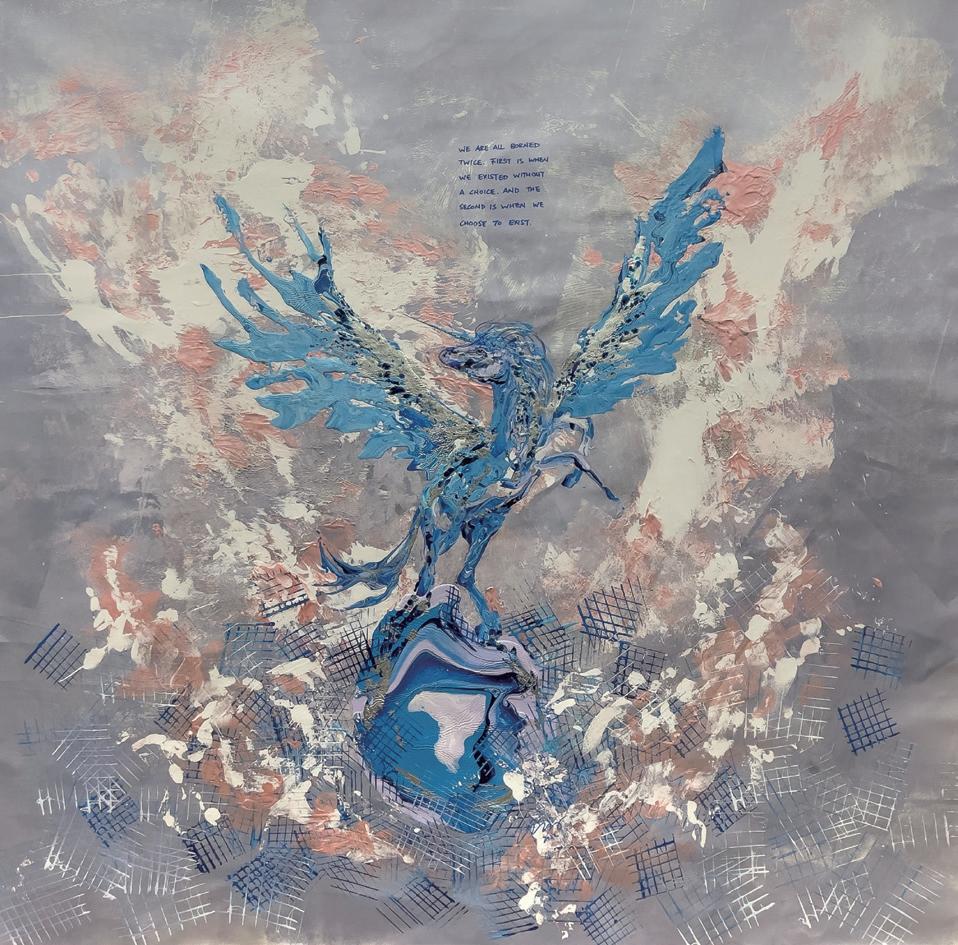
Demos Chiang, Born, 2022. Mixed media, canvas, a poem inscribed in English, 140x140cm.
Q: In addition to painting, your work also includes some sculptures. When did you start creating sculptures?
Demos Chiang: The reason I started to create sculptures, was related to the Chengdu Biennale in 2021. The curator Lu Peng asked if I was interested to participate in the Chengdu Biennale. I still remember what he said, “I have no interest in your paintings. I want to see your sculptures.” To answer this challenge, I went back to my design background. During my years in design, l created few public art. And I am very familiar with using softwares to generate forms. This opportunity ambled me to link my design background with my art.
In search for a unique artistic mark, I reflected on the COVID situation, choosing “vacuum” as an expression. Suspension was a global experience. Everything stopped. But still await to restart when post COVID comes. Vacuum sealing is also a modern technology that in term reflect on the traditional Chinese philosophy: everything can be infinite. Regardless of its size. All we are waiting for is the right timing.
Q: How do you feel about your cooperation with Whitestone Gallery?
Demos Chiang: It’s all about the people. I met the owner of Whitestone gallery, he is my age. And we have a connection at first site. I believe working with the right people is the most important element to success. After all, our time on earth is limited. We should always work with people that we love.
Furthermore, Japan has a linkage to my own background. Disregarding the political situation, I believe Japan is still the hub for international talents. And this make it to be the ideal place for my first international show.
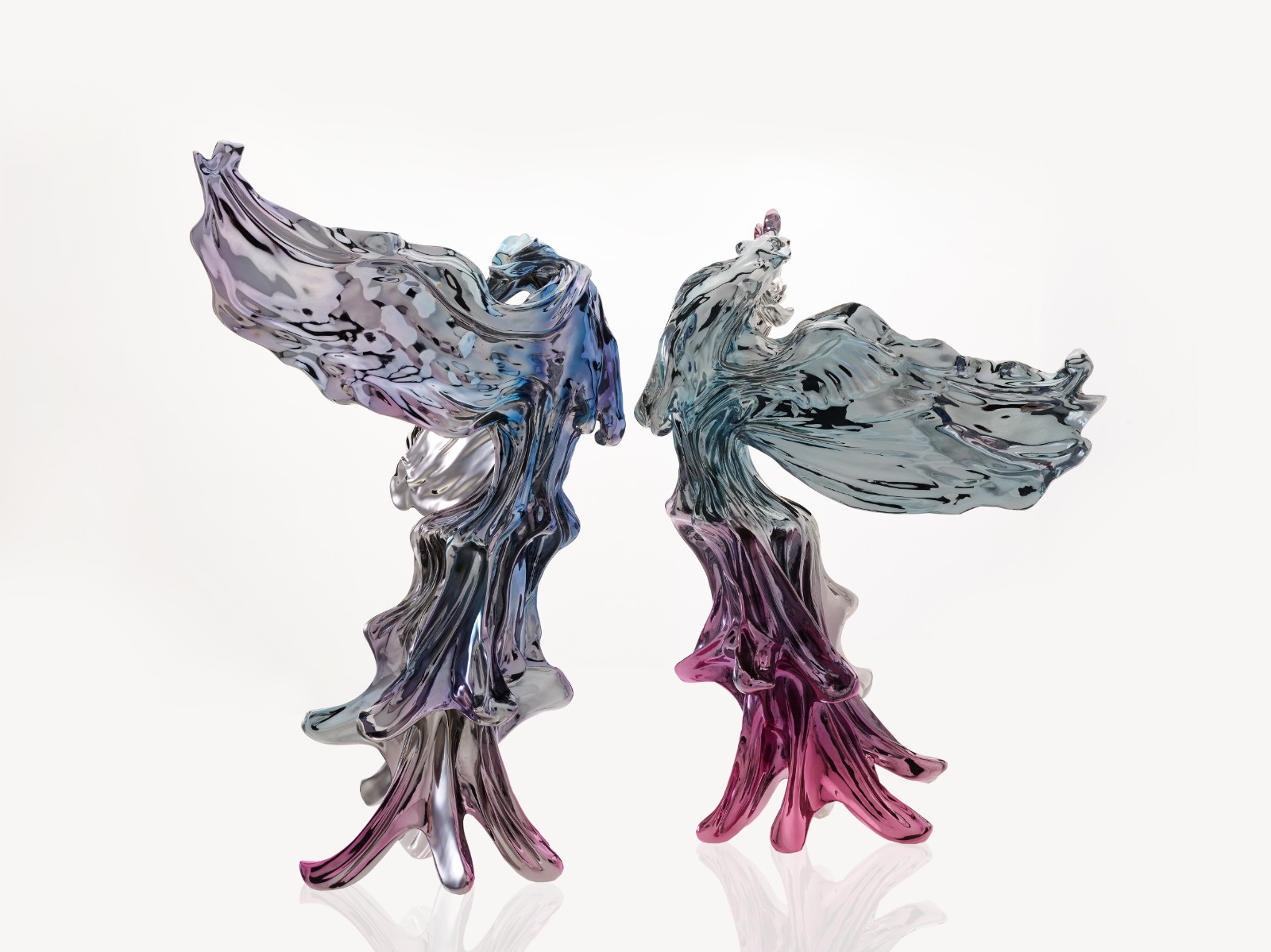 Demos Chiang, Phoenix Dance, 2023. 316 Stainless steel, L 27.5 x W 53.5 x H 60cm.
Demos Chiang, Phoenix Dance, 2023. 316 Stainless steel, L 27.5 x W 53.5 x H 60cm.

Demos Chiang, Gate Gods, 2022. Dehua white porcelain sculpture, a pair.
Freeze, L 36.0 x W 12.0 x H 21.5 c m
Release, L 25.2 x W 15.7 x H 17.9 c m
Q: In the latest exhibition at Whitestone Gallery, you use rich creative methods and materials, such as acrylic and even lacquer, how did you choose materials, which materials do you prefer, and what kind of artistic effects do you try to present with them?
Demos Chiang: The shift in material was a result of a self-realization. At the beginning of my art career, all the agents wanted to down play my experience as a designer. They thought design is inferior to art. This concept I had never agreed to. So when I started to gain confidence and know who I am as an artist, I decided to use interior design martial sand tools as the base for my painting. Through combining different lacquer and use different tools, I was able to create patterns, colors that I cannot fully control. As the chemical will react to one and other to generate Random effect. This process is very poetic, similar to the tradition Chinese ink splashing. Yet, it’s with a modern twist that echoes with my life experience.
To paint in an abstract way with a figurative image often surfaced an image that all can have their own interpretation with. I wish that my works can communicate positive values and make people pulse their life for a bit. To breathe and think what they are feeling.
Q: Your educational and cultural background have dual influences from Eastern and Western cultures, which is also reflected in your work, such as poems inscribed in the work, but in English. How do you integrate the cultural factors of the East and West? How do you think of these cultural differences?
Demos Chiang: Writing English poems on painting provided another link for the east meets west concept. I don’t believe tradition should be modernized, nor cultures should be merged. I believe that everything should be respected. Hence, I often use sewn as a verb for my work.
Eastern philosophy is all about imagination. Western science is all about facts. Putting the two together side by side, is how I create my art.
In the past, the gap between the Eastern and Western cultures was relatively large. For example, the art of the East, paid a lot of attention on negative space which does not need much modification, but pursues the artistic conception. Western art has different approach. Whether it is realistic, abstract or expressive, they all appear to be more experimental and more external, in contrast to the more restrained eastern art.
In the last two decades, Eastern art and culture have been affected by the West , but I have always believed that the eastern culture will become a mainstream culture in the years to come.
Q: Which artists do you particularly love and are affected by?
Demos Chiang: In addition to Eastern Art, I have also been influenced by many Western artists, of course, including Jean-Michel Basquiat, as well as Andy Warhol, Yayoi Kusama, etc., I also like Jackson Pollock. Of course, if you like them, you will be affected by them. You will “grab from both the left and right”, and then fused and try to develop yourself in the process. For example, I use a lot of drip painting in my creation to construct a representational image, which is affected by the Abstract Expressionism.
 Demos Chiang, I Will Follow You, 2022. Mixed media, canvas, a poem inscribed in English, 38x90cm.
Demos Chiang, I Will Follow You, 2022. Mixed media, canvas, a poem inscribed in English, 38x90cm.
 Demos Chiang, Complex Beauty, 2022. Mixed media, canvas, a poem inscribed in English, 100x72cm.
Demos Chiang, Complex Beauty, 2022. Mixed media, canvas, a poem inscribed in English, 100x72cm.
Q: There are landscape paintings and animal paintings. Why do you choose to fuse them?
Demos Chiang: Actually, in my paintings, landscapes and animals were originally separated. But in 2022, I painted a 10 meters piece. A total of 11 zebras. When I finished the painting, I realized that the stripes of the zebras had become waterfalls and landscape from a distance. That is when landscape animal started to take its form.
In Taoism, flooring the course of nature is the core concept. Especially after the pandemic, follow nature became profound. Animals and humans both live in nature, but have different respect for nature. Human are animals, but we tend to want to control and overpower nature. That cause an imbalance in the system. And it’s the root to negative vibes. Landscape animal tries to recall the balance human should have with nature. As animals, as humans.
Q: Your learning background is closer to the West, but it is said that you have a better understanding of Eastern philosophy. Can you share your thinking?
Demos Chiang: Personally prefer Eastern philosophy, because I always feel that Western philosophy is too “scientific” and lacks imagination. I think imagination is very important, because it reveal the humanity in us.
Q: Is the future creative direction for you within the controllable range, or to a certain degree of uncontrollable state? Do you have a clear plan and direction?
Demos Chiang: Throughout my life, I never liked to live a predictable life. I often use the phrase warrior to define myself. Everything has its own flow. What I can do is simply prepare myself to a point that I can dance and take on any challenges. Hence, I don’t have a clear direction on where to go. But I am prepared to fully embrace what will.
 Demos Chiang, The Beginning, 2022. Mixed media, canvas, a poem inscribed in English, 90x140cm.
Demos Chiang, The Beginning, 2022. Mixed media, canvas, a poem inscribed in English, 90x140cm.
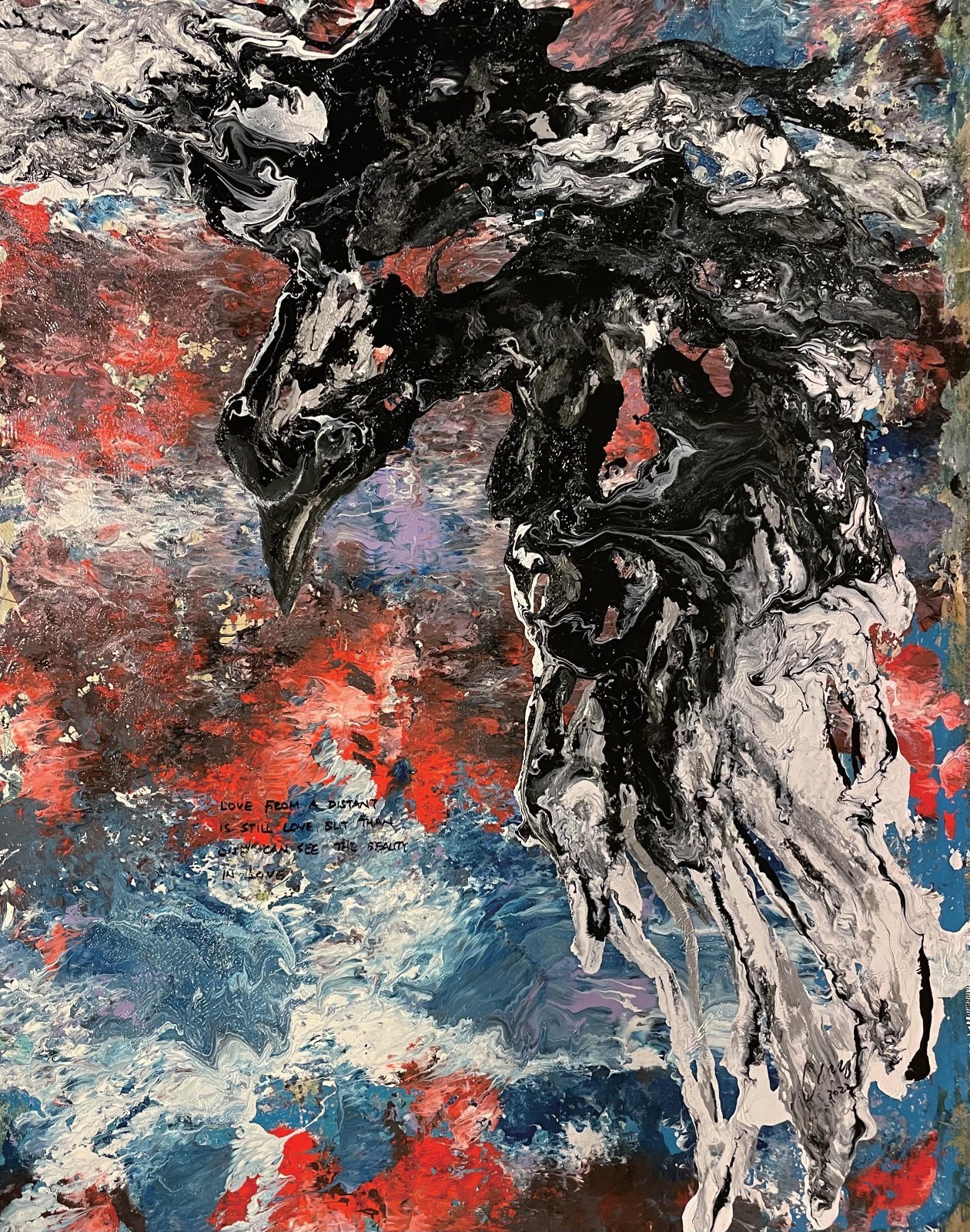 Demos Chiang, Love from a Distance, 2022. Mixed media, canvas, a poem inscribed in English, 90x70cm.
Demos Chiang, Love from a Distance, 2022. Mixed media, canvas, a poem inscribed in English, 90x70cm.
Q: You just mentioned your interaction with artists such as Zhang Daqian. You think that artists probably have a state of freedom or even close to a crazy state. How do you understand the relationship between freedom and madness?
Demos Chiang: The madness of the artist can be viewed as degree of rebellious . To live in his own small world with his own value, this is a state of freedom. For me, I never got out of adult lessons. If I had the choice and ability to exercise some form of madness, I believe I will. That is how I make sure that I am still just me.
I try my best to protect my own little world, but because of my background, sometimes I still have to interact with the bigger world. Before conducting art, this pull troubles me. But now, I can retreat into my own world at anytime and anywhere. This little world is very simple, it consists my mother, kids, my love and my friends. They are my comfort zones. I don’t care much about others, because I am still not strong enough to handle the entire world.
Q: You used to study finance and later worked as a designer, what exactly did you find outside of art, attracting you to find it in art?
Demos Chiang: People said once you become a father, you will view life differently. That is very true for me. After becoming a father, all I wanted to do is to leave braves stories behind so my kids will talk about me to their friends, kids…that is the most important mission.
With that in mind, everything I do should be an adventure. My studies and experience are just skills I gain along the way. I will not be limited by skills. And bravery extend outside of adventure. True bravery is when one can honesty accepts oneself. This is what art had given me.
All I can say is that for the time being, art will be the next chapter in my life story.
About the Exhibition

Dates: January 13 - February 4, 2023
Venue: Ginza New Gallery
Address: 6-4-16 Ginza, Chuo-ku Tokyo, 104-0061, Japan
Opening Hours: 11:00 - 19:00
Closed: Sunday, Monday




























